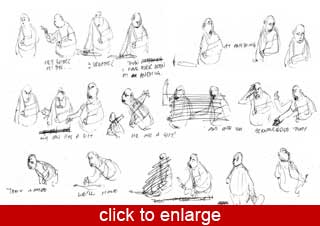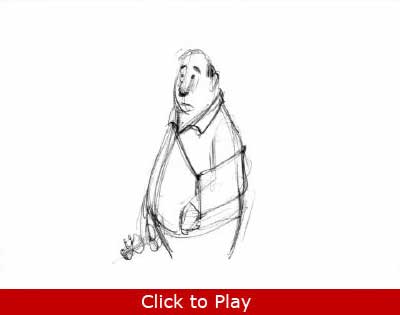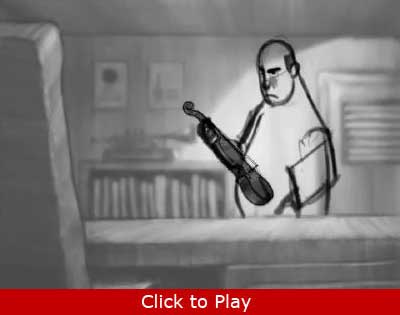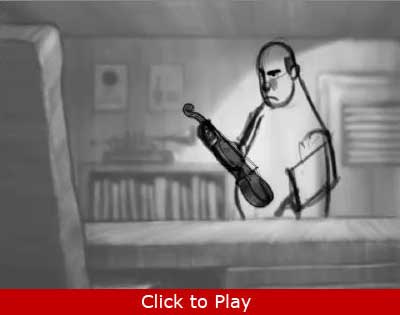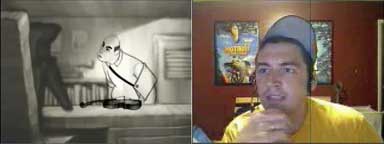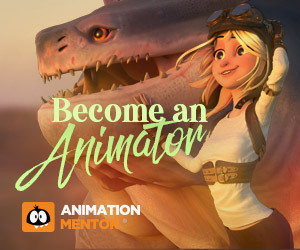Chan Ghee Leow
Interview conducted by Eric Scheur
At the beginning of every month here at the 11 Second Club, we are given a sound file to listen to and animate to. It might be one or several people speaking, and it might offer any number of ideas for who these characters are and what they're talking about. It's often tempting to create an eleven-second gag with a setup and punchline, all in one self-contained piece of animation. Most of us follow this path.
And then there are animators like this month's winner, Chan Ghee Leow. Chan Ghee decided that his clip would not tell a complete story in and of itself. Rather, his scene would hint at a much larger drama existing before we see his scene begin, and likely to have ramifications after we have seen the last frame. I love this approach, because it gives the scene a context to exist in. It doesn't matter that we don't know the context--as long as the animator knows and understands the context, the mood comes across honestly.
Congratulations to Chan Ghee on dark and brooding winning entry. I am happy to be able to share with you the conversation I had with Chan Ghee about his approach to the story and the animation that came from it. Read on!
-Eric
You've clearly spent a lot of time building your drawing skills. Which came first, the desire to draw or the desire to animate?
I knew I wanted to be an animator when I saw a clip of Glen Keane doing a demonstration of Ariel not long after The Little Mermaid had just been released. Even though I was only about 9 at that time, I was pretty much set on becoming a 2D Disney animator (I was very specific at that time). I spent a lot of time developing my drawing skills because I knew that I needed to be a good draftsman if I wanted to animate well.
How long have you been teaching animation?
This is actually my first time teaching animation to animation students. This particular stint started in May this year. I have previously taught life drawing and illustration in a design college back in Kuala Lumpur for about 2 years before coming to New Zealand to pursue 3D animation studies.
What are some of the common missteps you find your students making, and how do you work to help them overcome those obstacles?
I have noticed that students often want to just jump in and start animating (especially in 3D) before they find out who their characters are and also the context in which their characters appear. Without knowing the history of all the elements in a scene (characters, props, environment etc), I do not believe any scene can be animated convincingly.
To illustrate this point, I often ask my students to look around the classroom and think about the history of everything that exists in that 'scene'. Everything that exists in the classroom, from the empty cans of 'V' lying on the desks to the broken chair sitting in the corner, has a history that brought them to their present state. Nothing that we see in a shot should appear as though it has come from nowhere. It does not matter if the audience never sees the extent of the thought process behind these shots. It only matters how this information is used to support the performance of the characters in the scene.
I have also noticed that students new to animating tend to favour acting choices which literally reflect what the characters are saying. this often results in an overacted performance which comes across as artificial. I think this happens because animation in nature is a very slow process, which makes students think that they have not done enough to 'animate' their characters. My students animate in 3D, so it is quite easy for me to illustrate this point once I get them to playblast their animation. We really only act out what we say when we cannot communicate clearly via speech (as in loss of voice or giving directions to a foreigner who does not speak the same language), or when we want to emphasize something we are saying.
Your blog (http://ghoobist.blogspot.com/) has examples of your digital painting and design work. Do you practice any other forms of art? Sculpture, music, theatre?
I used to participate in amateur school plays when I was in secondary school. I was performing as well as overseeing the painting of some rather large backgrounds for the productions. My first professional gig was with The Actors Studio. It was an ensemble piece performed in 2001 called 'The Silly Little Girl and the Funny Old Tree'. I went for the audition because I wanted to take a break after I had finished college and go do something different to recuperate from my final animation project. I quickly realized after the first few workshops that what we were doing was actually very applicable to animation. I would still very much like to get involved in theatre if ever there was an open audition anywhere.
I tried teaching myself the guitar last year, but that fell aside when jobs became scarce this year and I had to pretty much focus on the miscellaneous jobs I was doing to stay alive. Guitar playing and clay sculpting are definitely high on my list of skills to pick up once my job situation becomes a bit more stable.
Talk about how techniques from other disciplines have helped you when you're animating.
I had my first professional break last year when I was hired as a 3D character animator on a TV series called 'The Adventures of Voopa the Goolash'. On that particular production, I felt that having had some experience in hand drawn animation was helpful in the staging and timing of the characters I was animating.
When I was animating 'Keeping It Quiet,' I found that I could rely on my digital painting skills to quickly render out the backgrounds required for the shots. This allowed me to feel more involved with the characters once the mood and atmosphere had been established. This was actually the first time I had done any background paintings that appeared as part of a final animation piece.
You spoke earlier about how important it is to know the context of everything in your scene. Where did the story of your winning entry, 'Keeping it Quiet' come from?
I have always believed in allowing the material that I am working with tell its own story and not interrupt it by imposing inappropriate ideas on it. Based on the audio, I wanted to create a character that was visually vulnerable, and the first thing that came to my mind was the image of a middle-aged man in an arm sling. I knew I did not have much time to play around with other ideas, so I decided to trust my instincts and use that as my starting point. I was also trying to work economically, so I chose to omit the son from the scene. Without the son in the room, I needed a way to hint at the 'gift' that he spoke about, so I decided to use a prop for that purpose. A 'villain' that held a respectable position in society was also required to complete the scene. Up to that point, there was still no real backstory, just the bare elements which I knew instinctively I would need. I was just hoping and praying that they would come together when I fleshed out the story later.
I wanted this piece to look and feel as though it were part of a bigger picture. For it to be convincing, I needed to know what had happened before this moment took place in the story. Even the last frame that hypothetically took place before my shots was important because without it, I would not have known what to draw in the first frame of my animation. The character would have ended up with an ambiguous pose and a bland expression on his face had I just gone in and drawn him without first establishing all these things. I also had to create the conversation that took place before the first line in the given audio was delivered.
After much brainstorming, the following was the plot that I decided to stick with:
Timmy's decision to pursue a career in music has never had Herbert's full support, which is increasingly putting a strain on their relationship. After much persuasion, Herbert finally agrees to let Timmy audition for a place at a prestigious school run by an old music master. Due to a heated argument the night before the audition, Timmy's performance the next day is gravely affected. The following evening, the car that Timmy and Herbert are travelling in crashes as Herbert tries to avoid an oncoming vehicle that has swerved into their lane. Herbert manages to crawl out from the overturned car with a broken arm, but Timmy suffers serious injuries. Herbert manages to catch a glimpse of the other driver before he speeds away. He recognizes him as the old master who runs the music school at which Timmy has just auditioned. Timmy's violin, which is found near the scene of the crash, is brought back to the music school which happens to be the closest building to where the accident has happened. The old master, knowing that Herbert has seen him, now wants to make sure the incident does not tarnish the good image of his school.
Master: I'm sure your son will be pleased to be reunited with his violin. It was found intact at the…scene. But that's not the reason why I wanted to meet you today. I have a proposition for you.
Dad: You were drunk...and my son is still in the hospital.
Master: I know your son came to audition for a place …but to put it simply, he just didn't quite measure up.
Dad: He was going through a lot of stress.
Master: Here's the deal. I shall take it upon myself to cover your son's medical fees as well as ensure that he gets a place in the school...without the audition this time.
Dad: So you're going to let him in just like that!? We don't need your sympathy! He's better at this, than I have ever been at anything. My son has a gift. He has a gift! And once you acknowledge that, then maybe, we'll have something to talk about.
*I need to learn how to write better scripts!
Are these character designs that you have used before, or did you design them specifically for this piece?
The characters have been designed specifically for this piece. I had originally wanted to animate this piece in 3D using the free online model called Alfred. But as I have never been a very strong 3D modeler, I did not feel confident enough to model the arm sling and the violin quickly. I decided then that I would animate this piece using traditional hand drawn methods. I thought it would be much easier to animate the violin rotating in perspective frame by frame rather than spending hours modeling it in 3D. What was I thinking!!? Anyway, I pretty much used Alfred as the starting point when I was designing the look for Herbert. As for the old master, the design stayed very much the same as the first drawing I had made of him. I did not realize how much he looked like Mr. Burns until someone pointed it out in the forum. Talk about accidental plagiarism!
There is often a temptation for an animator to move a character when stillness is called for, so I'm intrigued by the menacing stillness of the Master. Was there a point where you started to animate him doing more and then decided to keep him still, or was he always going to have that menacing glare in your mind?
I knew from the beginning that the old master was just going to be a supporting character in the shots and that his acting was going to be minimal. Even though his presence was important to the piece, I really wanted to focus on Herbert's performance. I had initially planned for the old master to shift his gaze after the blink and very subtly turn his head downwards as he pondered what Herbert had said. But I ran out of time and decided to keep everything still except for his blink.
Tell me about your animation process.
I think it might be better for me to talk specifically about the animation process for this piece. I first played the given audio on loop for a couple of minutes. After the first few cycles, snippets of the performance began to take shape in my head. I then quickly thumbnailed all the gestures that Herbert would make, relying very much on gut feeling to do so I think it might be better for me to talk specifically about the animation process for this piece. I first played the given audio on loop for a couple of minutes. After the first few cycles, snippets of the performance began to take shape in my head. I then quickly thumbnailed all the gestures that Herbert would make, relying very much on gut feeling to do so.
I wanted to do a video reference of me acting out the gestures that I had just thumbnailed, but it felt really contrived trying to hit these poses in time with the audio. I concluded that what I had pictured in my mind was how Herbert would act as opposed to how I would personally do it if I were in his shoes. I hope that is not a justification for bad acting skills on my part. I decided that I would only use video references if I had difficulty animating a specific gesture.
The second step was to scan a more refined version of the thumbnails and use them as a rough test for timing.
I also prepared a turnaround template for the violin which I later used to replace the rough drawings of the instrument as it turned in perspective with Herbert's right hand.
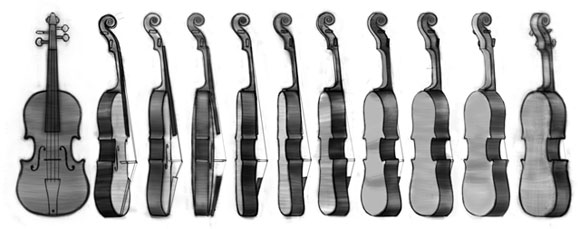
I was making a lot of these procedures up as I went along because I have not done any real 2D character animation in the last couple of years. In fact, I saw this as an opportunity to try out a new technique of animating using Photoshop and Flipbook together. Every layer in Photoshop represented a single frame of my animation. These animated layers were later imported as individual frames into Flipbook. I quite enjoyed animating like this as it saves me having to scan my images and it did not feel wasteful if I needed to throw out drawings. The only problem was that the file got a little heavy by drawing #159.
I like the Herbert's eyebrows; can you talk about them for a bit?
I had initially animated Herbert with just his eyebrows for expressions. If I was able to communicate his emotions with just his eyebrows, I knew that half the battle was won. It really made me focus on the shapes of his eyebrows because I was not drawing any other facial features at the time. I also noticed that his thick eyebrows worked really well graphically against the 2 patches of black hair at the side of his head.
The mouth shapes were put in after the rough inbetweens were done.
Eyes and blinks were the last thing I animated on the face.
How have your peers helped you with this scene? Did you get advice from anyone on the forums or from friends, or even from any of your students?
I stayed away from the forum in the beginning because I did not want to see something that someone else had done and start doubting my own ideas. Even before I showed my roughs to my girlfriend, I had already nailed down at least 70% of the acting. I felt like I would not be able to benefit from any feedback if I did not already know the reasons for the decisions I made. It would have really confused me if I took every suggestion into consideration without knowing what I wanted in the first place.
My girlfriend was the only person whom I was bouncing ideas off of for this piece. I felt that it was enough feedback for me because she is by nature a very perceptive person and understood what I was trying to convey in my animation. It was actually she who prompted further analysis on what Herbert truly meant when he said, 'And once you acknowledge that, then maybe, we'll have something to talk about'. We wondered if it was actually the old master who wanted a favour from Herbert all along.
The analysis of the audio was made during the students' 2-week break as part of my preparation for the animation class I was going to conduct. I thought I had better familiarize myself with the material before actually presenting it to the students for discussion. I ended up feeling really excited about the whole idea and decided that I would finish it up for the competition. By the time I presented my rough animation to the class, the drawings were just about to go into clean-up. I was not keen to make any big changes at that point. Not if I wanted to make the competition deadline anyway.
What was one of the most challenging things about this particular piece?
Animating the violin rotating in perspective! Coming up with a plausible plot that revolved around an 11-second audio track comes second.
What was your initial reaction to the eCritique?
I was really excited about it because I ended up watching it on the projector with some of my students, turning the tables around and offering my work up for critique for a change! It was a little embarrassing, but it was a good learning process for all of us.
Nick's suggestion to take advantage of Herbert's injured arm and use it to strengthen the original acting choices was something that I definitely appreciate. I am also paying more attention now to the second shot of the old master. I did not quite realize just how valuable that second shot was.
I am now paying more attention to the way audiences watch an animated performance on the screen. The concept of staging within the motion of the animation itself is something that is new to me. Nick's suggestions about anticipating the stabbing motion that Herbert makes before he leans forward and says, 'My son has a gift' has made me look at staging from a completely new angle.
Do you intend to return to this piece to incorporate the suggestions made in the eCritique?
Definitely! I am currently working on my second concept artbook in preparation for future job applications. Once that is done, I would have some time to return to this piece to polish it up. I would be really keen to share it on the forum when it is finished.
Is there anything you'd like to add about your thought-process or experience in July's competition?
It's been a GREAT experience! I have not felt this excited about any personal work in a very long time. Participating in this competition has definitely re-ignited some of the passion I have always had for animation, especially hand drawn animation. I very rarely stay up late to work on personal projects. But this piece got me staying up until at least 2 or 4am on most nights and then springing out of bed in the mornings raring to go again. It was probably bordering on the obsessive, but I reckoned I had better make full use of this sudden burst of energy and moderate it when I was ready to incorporate some of this craziness into my daily life. I had forgotten just how much fun animating in 2D can be despite having to do ALL the inbetweens by hand! I would definitely submit another entry in the near future once I recuperate from this one.
What advice would you offer to a beginner who wants to enter the competition? Where would you suggest they start? For example, perhaps there's something you remember struggling with for a long time and then suddenly it clicked into place and your understood?
I would say take some time off to do some exercises with the bouncing ball. It does not matter if you are going to animate in 2D or 3D, you simply cannot overlook the importance of the bouncing ball.
Be extremely critical of your own work, especially if you do not have the advantage of going to an animation school. Do not try and justify the weaknesses that you see in your work. Do not ignore that tiny voice in your head when it says that something does not look quite right in your animation. Ask yourself why it appears odd, what you can do to make it better and then take the necessary steps to amend it. If you cannot see anything else you can do to improve it, then try and see if you can get a second opinion.
Start with an idea. Make sure it REALLY excites you, otherwise you will lose interest halfway. Once you have your idea nailed down, commit to it. Throw out anything that is distracting, ambiguous or contradictory. Focus on communicating this really awesome idea that you have in the clearest, most engaging way possible. Do not focus on winning the competition, because you will start assuming what people want to see.
I hope this helps. I do not know if this is applicable to everyone, but it seems to have kept me quite happy so far :)
- Chan Ghee
Discuss this interview in the forums
comments powered by Disqus






